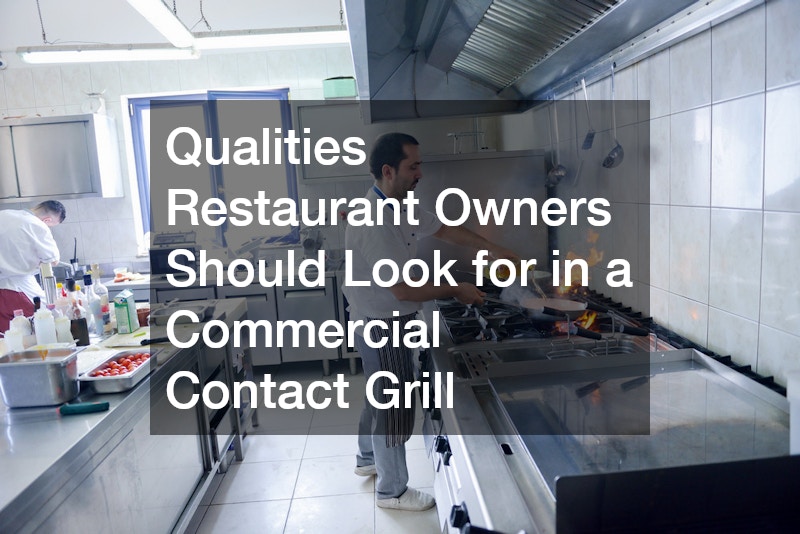In this article, we will explore the key qualities that restaurant owners must consider when choosing a commercial contact grill. Efficiency, durability, and functionality are just a few of the critical factors that can impact your kitchen’s operations. Let’s delve into the most important questions to ask when evaluating contact grills.
1. What is the importance of heat distribution in a commercial contact grill?
1.1 Significance of Even Cooking
Even heat distribution is essential for ensuring that food is cooked uniformly, preventing some areas from being overcooked or undercooked. This consistency is crucial for maintaining food quality and customer satisfaction in a restaurant setting.
Hotspots can lead to an inconsistent dining experience, which may affect customer perceptions of a restaurant. Hence, an efficient contact grill must feature a system that distributes heat evenly across its surface.
Furthermore, even cooking minimizes food waste, as ingredients are cooked more uniformly. This efficiency, in turn, supports operational efficiency and cost-effectiveness, vital for maintaining profitability.
1.2 Role of Material in Heat Conduction
The material of a grill plays a significant role in its ability to distribute heat effectively. Common materials like cast iron and stainless steel have different thermal conductivity properties that affect grilling performance.
Cast iron, known for its excellent heat retention and distribution, is often favored for intense and even cooking. On the other hand, stainless steel offers quicker heating and cooling, which can be beneficial for specific culinary needs.
Understanding these material differences is crucial for making an informed decision. Restaurant owners should evaluate how these materials meet their cooking requirements and operational style.
2. How does size and capacity affect your choice of a contact grill?
2.1 Matching Grill Size with Restaurant Needs
When selecting a contact grill, aligning its size with the restaurant’s volume of service is vital. A grill that is too small may lead to bottlenecks, whereas a larger one could be an unnecessary expenditure and space consumer.
A thorough assessment of the daily demand and peak service times can help in choosing the right size. This ensures the grill can handle the volume without compromising performance or quality.
Ultimately, aligning grill size with operational needs helps maintain efficient service delivery. This balance contributes to customer satisfaction and optimized use of kitchen resources.
2.2 Space Considerations in Your Kitchen Layout
In the restaurant industry, efficient space utilization in the kitchen is crucial for smooth operations. Choosing the right-sized contact grill ensures that it fits well within the existing kitchen layout without causing obstruction.
Space constraints may require opting for a more compact unit or modular design. These choices can help maximize workflow efficiency and prevent unnecessary clutter during peak hours.
Moreover, careful planning of kitchen space allows for safer working conditions. By avoiding overcrowding, restaurant staff can navigate the kitchen with ease and minimal risk of accidents.
3. Why is the grill plate material a crucial consideration?
3.1 Differences in Grill Plate Materials
Grill plate materials significantly influence the performance and longevity of a contact grill. Cast iron and stainless steel are two popular choices, each offering distinct advantages.
Cast iron plates are known for their durability and excellent heat retention, making them ideal for searing and even cooking. Contrarily, stainless steel plates are easy to clean and resist rust and corrosion.
Choosing the right material depends on the specific cooking and maintenance needs of a restaurant. Restaurant owners should weigh the pros and cons before making a decision.
3.2 Impact on Cleaning and Maintenance
The choice of grill plate material affects how easy it is to clean and maintain the grill. Cast iron requires regular seasoning to prevent rust, while stainless steel offers low-maintenance care.
Cleaning frequency can impact downtime between shifts, affecting kitchen efficiency. Grills that are easier to clean can lead to faster turnaround times, contributing to better overall kitchen performance.
Moreover, the right material can also influence the cost-effectiveness of the grill. Materials that require less maintenance can reduce long-term operational costs.
4. What safety features should be prioritized in a commercial contact grill?
4.1 Built-in Safety Mechanisms
In any commercial kitchen, safety is paramount, and grills should come equipped with essential safety features. Overheat protection and automatic shut-off mechanisms are crucial to prevent accidents.
These safety measures help reduce the risk of fires and equipment damage by ensuring the grill operates within safe temperature limits. Such features are vital for maintaining kitchen safety and compliance with health and safety regulations.
4.2 Ergonomic Design for Safe Handling
An ergonomic design in a contact grill minimizes the risk of accidents and workplace injuries. Smart design elements like insulated handles and easy-to-access controls enhance safety during operation.
Grills with thoughtful ergonomic designs can help prevent common kitchen accidents, such as burns and cuts, which can disrupt service and harm employees. Such designs make the work environment safer and more efficient.
5. How do energy efficiency and power consumption impact your decision?
5.1 Long-term Cost Implications of Energy Use
Energy efficiency is a crucial factor in selecting a contact grill, as it directly impacts the operational costs of a restaurant. High energy consumption can lead to significantly higher utility bills over time.
Grills that are designed to use energy efficiently can lead to considerable cost savings and reduce the environmental footprint of a business. Incorporating energy-efficient equipment is an investment in a sustainable future.
5.2 Evaluating Energy Efficiency Ratings
Energy efficiency ratings provide a clear indication of how much energy a grill consumes during operation. These ratings help compare different models to identify the most cost-effective option.
Understanding energy efficiency ratings allows restaurant owners to make more sustainable choices that align with their financial and environmental goals. An efficient grill not only saves money but also supports a restaurant’s commitment to sustainability.
.



